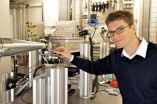(Press-News.org) Just about everyone has a story about being trapped in the wrong job, flip-flopping careers in search of one that fits, or just wasting time with the guidance counsellor.
Imagine the impact of a new system that would easily and accurately identify individual strengths, point people toward occupations in demand, estimate the likelihood that they would be good at them and help determine whether they would enjoy them. It would be the human resources equivalent of speed-dating, but with a higher chance of going home happy.
"This is going to seriously improve people's ability to find jobs that they love, that they are good at, and that are in demand," says Dr. Piers Steel, an associate professor of Human Resources and Organizational Dynamics at the University of Calgary's Haskayne School of Business.
Technically known as "synthetic validity", such a system has been viewed as the holy grail of business academics for more than half a century. Earlier this year, Steel and a group of colleagues from across the United States showed working models and had the idea stress-tested at the highest level. It is the focal article in the current issue of one of the top academic journals for human resources, Perspectives on Science and Practice.
"The best minds from our entire field took time to look it over and as a result, synthetic validity has now been vetted and approved," says Steel. "Every expert thought it was a great idea."
This new selection tool would also be incredibly valuable, generating worldwide benefits worth trillions of dollars per year—more than $100 billion to the Canadian economy alone—says Steel.
"Any company that's interested in hiring, from huge multinational firms to simple ma-and-pa stores, would have access to a customized selection system of the highest quality at a tiny fraction of today's costs and almost instantly. We could select people for jobs and jobs for people, similar to Monster.Com, except far better."
When it comes to Canada's flagging productivity— an issue that has recently been troubling Canadian bank economists—Steel says synthetic validity would allow us to not only catch up with the United States, but surpass them.
"The benefits will be astounding, substantively decreasing unemployment with a sizeable increase to national productivity."
Though the conceptual groundwork is completed, a working system needs to be built. The finished product will draw upon an extensive database comprised of tens of thousands of previously assessed employees from at least 300 different jobs.
This will likely require the collaboration of both public and private sectors, but Steel stresses it will be worth the effort.
"If you want a way out of our present economic problems, here it is. It maximizes the benefit from the most important capital we as a society have—human capital, ourselves."
Steel was also recently selected for a prestigious Killam Trust Emerging Research Leader Award for his efforts. The Killam Trust is devoted to distributing the $400 million estate of Izaak Walton Killam and his wife Dorothy towards advanced education and research in Canada.
INFORMATION:
His key articles on synthetic validity can be viewed at:
http://bit.ly/dkl3WZ
http://bit.ly/9xxRDt
http://bit.ly/cubtv4
END
Understanding how the brain recognizes objects is a central challenge for understanding human vision, and for designing artificial vision systems. (No computer system comes close to human vision.) A new study by MIT neuroscientists suggests that the brain learns to solve the problem of object recognition through its vast experience in the natural world.
Take for example, a dog. It may be sitting nearby or far away or standing in sunshine or shadow. Although each variation in the dog's position, pose or illumination produces a different pattern of light on the retina, ...
A new study uncovers a protein modification that may contribute to the formation of neuron-damaging neurofibrillary tangles in the human brain. The research, published by Cell Press in the September 23 issue of the journal Neuron, may lead to new strategies for treatment of neurodegenerative diseases that result from pathological aggregation of tau protein.
Tau protein is common in the central nervous system where it helps to stabilize microtubules that form the neuronal cytoskeleton. Tau mutations have been linked with dementia and Alzheimer's disease (AD), and accumulation ...
Many genes code for proteins that have a "polyglutamine tract," several glutamine amino acid residues in a row. Nine inherited neurodegenerative diseases, including Huntington's disease and spinocerebellar ataxia type 1 (SCA1), are associated with mutations that cause abnormally long polyglutamine tracts. One theory suggests that accumulation of proteins with extra glutamines damages and kills neurons. However, there is evidence that glutamine tract expansion alone is not sufficient to cause disease.
Now, new research published by Cell Press in the September 23 issue ...
Two remarkable new species of horned dinosaurs have been found in Grand Staircase-Escalante National Monument, southern Utah. The giant plant-eaters were inhabitants of the "lost continent" of Laramidia, formed when a shallow sea flooded the central region of North America, isolating the eastern and western portions of the continent for millions of years during the Late Cretaceous Period. The newly discovered dinosaurs, close relatives of the famous Triceratops, were announced today in PLoS ONE, the online open-access journal produced by the Public Library of Science.
The ...
A study led by researchers at UC Davis has found how the bacteria Salmonella enterica — a common cause of food poisoning — exploits immune response in the human gut to enhance its own reproductive and transmission success. The strategy gives Salmonella a growth advantage over the beneficial bacteria that normally are present in the intestinal tract and promotes the severe diarrhea that spreads the bacteria to other people.
The findings are published in the Sept. 23 issue of the journal Nature.
"The human body normally has 10 times more microbes than human cells that ...
LA JOLLA, CA – September 20, 2010 –– A team at The Scripps Research Institute has detailed the structure of a member of the only remaining class of multidrug resistance transporters left to be described. The work has implications for combating dangerous antibiotic resistant strains of bacteria, as well as for developing hardy strains of agricultural crops.
The study was published in an advance, online issue of the journal Nature on September 22, 2010.
"Now with our crystal structure, scientists can for the first time figure out exactly how this transporter works," ...
Osteoporosis, a medical condition in which bones become brittle and fragile from a loss of density, is among the most common diseases in aging bones: In Germany around a quarter of the population aged over 50 is affected. Patients' bone material shrinks rapidly, leading to a significantly increased risk of fracture. In clinical research to date, osteoporosis is diagnosed almost exclusively by establishing an overall reduction in bone density. This approach, however, gives little information about the associated, and equally important, local structure and bone density changes. ...
Women who survive breast cancer often suffer from functional limitations that affect motion, strength and dexterity, which may adversely affect all-cause and competing-cause survival but not breast cancer survival, according to a study published online September 22 in The Journal of the National Cancer Institute.
Breast cancer survivors who have functional limitations that affect motion, strength, and dexterity are at the same risk of dying from a recurrence of breast cancer as physically fit survivors, but are more likely to die from other causes.
Breast cancer survivorship ...
SAN FRANCISCO, CA—September 23, 2010—Scientists at the Gladstone Institute of Neurological Disease (GIND) have uncovered new approaches to reduce toxic proteins in Alzheimer's disease (AD) and other neurodegenerative diseases. The results might lead to new treatments for these diseases.
"We examined a protein called tau that has been strongly implicated in Alzheimer's disease," said Li Gan, PhD, senior author on the study. "Tau forms toxic protein aggregations in the brains of Alzheimer patients."
Tau is a common protein in the central nervous system where it helps ...
FORT COLLINS – The hiatus of global warming in the Northern Hemisphere during the mid-20th century may have been due to an abrupt cooling event centered over the North Atlantic around 1970, rather than the cooling effects of tropospheric pollution, according to a new paper appearing today in Nature.
David W. J. Thompson, an atmospheric science professor at Colorado State University, is the lead author on the paper. Other authors are John M. Wallace at the University of Washington, and John J. Kennedy at the Met Office and Phil D. Jones of the University of East Anglia, ...


